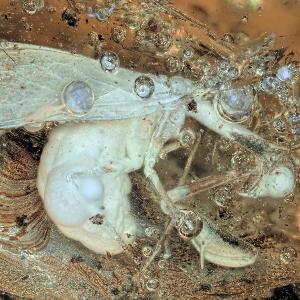Paleobiology: First adult mantis lacewing from Baltic amber
8 Feb 2022
LMU zoologist Viktor Baranov reports in Fossil Records.
8 Feb 2022
LMU zoologist Viktor Baranov reports in Fossil Records.

Image: V. Baranov
At first glance, they resemble praying mantises, but they are not: mantis lacewings (Mantispidae) belong to the lacewings (Neuroptera) and occur worldwide, with around 400 species currently in existence. While numerous fossil remains have survived from the Cretaceous, very few have been found from the subsequent Paleogene period. Scientists led by LMU zoologist Viktor Baranov have now discovered an adult specimen from this period in Baltic amber, the first such ever to be found.
“This is all the more amazing as Baltic amber is one of the best studied fossil deposits in the world, from which over 2,000 species have been described,” says Baranov. “Although the specimen is relatively small at 14 mm in length, it is very useful in helping us analyze the diversity of shapes of fossil and extant mantis lacewings.” Mantis lacewings are predatory insects and, like praying mantises, have front legs that are adapted for ambushing prey. The researchers found that the diversity of shapes of these raptorial legs has much declined, starting from the Cretaceous. In their paper, the authors hypothesize that dramatic changes in ecosystems at the end of the Cretaceous period are responsible for this loss of diversity.
Viktor Baranov, Ricardo Pérez-de la Fuente, Michael S. Engel, Jörg U. Hammel, Christine Kiesmüller, Marie K. Hörnig, Paula G. Pazinato, Corleone Stahlecker, Carolin Haug, Joachim T. Haug: The first adult mantis lacewing from Baltic amber, with an evaluation of the post-Cretaceous loss of morphological diversity of raptorial appendages in Mantispidae. Fossil Record 2022